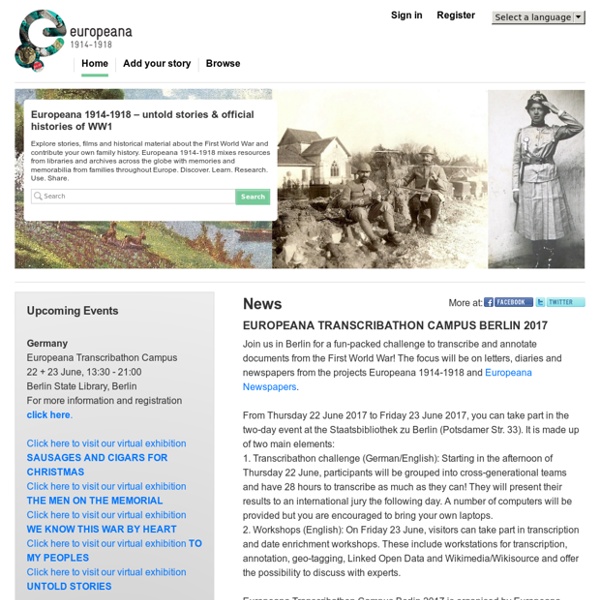WW100 New Zealand
A selection of sites and sources for learning about the history of the First World War from a New Zealand perspective, and the role your family members might have played in it. Soldiers inside the YMCA library in Beauvois, France. Ref: 1/2-013635-G. Courtesy of Alexander Turnbull Library, Wellington, New Zealand. Starting Places
iTunes U course and Multi-Touch Book on the First World War!
Whether you’re a school student or a WW1 enthusiast, you can now discover the different causes leading to the First World War with our new iTunes U course and Multi-Touch Book. The book and related course, available on iTunes in both Dutch and English, use fascinating historical materials to bring the months and years before the outbreak of war into focus. Many of these sources are drawn from Europeana 1914-1918, our dedicated WW1 site which brings together hundreds of thousands of items related to the war from heritage institutions and members of the public across Europe.
The Gallipoli campaign
Each year on Anzac Day, New Zealanders (and Australians) mark the anniversary of the Gallipoli landings of 25 April 1915. On that day, thousands of young men, far from their homes, stormed the beaches on the Gallipoli Peninsula in what is now Turkey. For eight long months, New Zealand troops, alongside those from Australia, Great Britain and Ireland, France, India, and Newfoundland battled harsh conditions and Ottoman forces desperately fighting to protect their homeland. By the time the campaign ended, more than 130,000 men had died: at least 87,000 Ottoman soldiers and 44,000 Allied soldiers, including more than 8700 Australians.
Anzac Day Collection
This documentary gave NZ viewers, for the first time, a Turkish view of the Gallipoli story. Produced for TVNZ and Turkish TV, it focuses on four young people, two Turks and two New Zealanders, descended from Gallipoli veterans, as they explore the grim reality of their ancestors’ experience. Six Māori Battalion soldiers camped in Italian ruins wait for night to fall.
The Mounted Soldiers of Australia — Australian Light Horse Association
Horses have played a special role in the story of Australia. For the first hundred years of European settlement they were the only means of transport across most of our huge country. Outside the few cities, ability to ride a horse was almost as basic as the ability to walk. The value of the mounted soldier in Australia was first shown in 1804 when redcoats of the New South Wales Corps set out in pursuit of a large force of rebel convicts who had broken out of the Castle Hill Prison Farm.
The Anzac landing at Gallipoli
The Anzac landing: overview Why did theAnzacs land? 25 April 1915: Anzac Cove, Gallipoli Historians still debate whether the Anzac troops were landed at the correct place. Why did the Allied commanders send Australian troops to land on a beach before rugged hills, ridges and steep gullies? What was the objective?
Digital Collection - NZ
You are here: Home > Digital Collection > Wars & conflict Heritage Digital Collection Home The Canterbury Aviation (N.Z.) Co.: the first hundred pilots
AE2 enters the Dardanelles, 1915 - History (9) - ABC Splash -
Overview This media resource contains content that shows images of war. World War I was fought on land, in the air, on the sea and below it. What role did AE2, an Australian submarine, play in the campaign to take Turkey's Gallipoli Peninsula in 1915?
Gallipoli time line
Gallipoli timeline - Events of 1915 25 April is Anzac Day. It commemorates the landing of the Australia and New Zealand Army Corps at Gallipoli at dawn on 25 April 1915, during the First World War. Anzac Day is now a memorial to all who have fought and died in every war New Zealanders have fought in since then.



